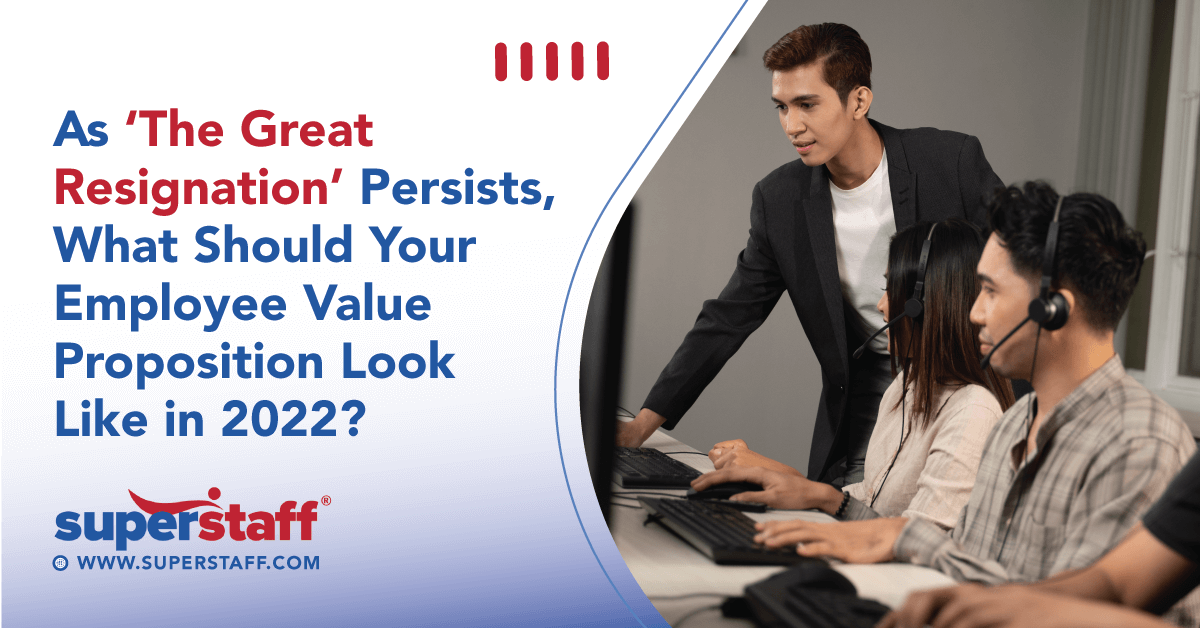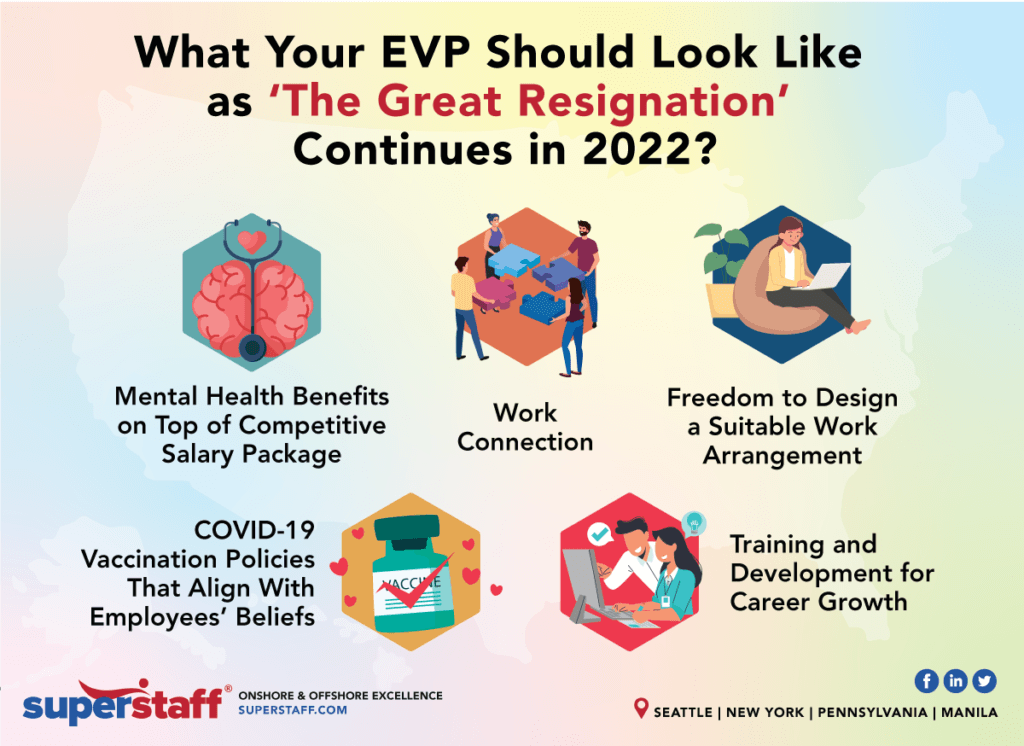
Before “The Great Resignation” created a seismic gap in the U.S. labor market, employee value proposition (EVP) comprised tangible and intangible benefits companies offer in exchange for employees’ skills, experience, capabilities, and work performance. Similarly, with many common work practices pre-pandemic, this definition is nearing obsolescence in the age of hyper-competitive talent acquisition.
Take a look at the following “Great Resignation” statistics:
- The number of job openings remained at 10.9 million (as of December 2021).
- More than a quarter of workers plan to quit their jobs and join “The Great Resignation” in 2022.
- 48.1% of employed workers are currently looking for other jobs.
The state of the current labor market requires employers to throw many conventional assumptions out the window, including the traditional definition of EVP. Today, EVP is the system of support employers provide to empower employees to achieve their full potential.
While both definitions boil down to employee benefits, the apparent differences in the wording and phrasing have significant value. The old description was transactional, the current, relational. The first sounds like something lifted out of traditional classified ads, the latter, a well-thought-out commitment. And these differences affect your employer branding.
Why Is EVP Important in ‘The Great Resignation’ Period?
The second letter of the abbreviation has the answer: Value.
Employees are seeking personal value and purpose at work. Beneath “The Great Resignation” lies another trend, which Gartner calls “The Great Reflection.” It is similar to Anthony Klotz’s prediction about “pandemic epiphanies.”
Since the pandemic, people have reassessed their priorities and what they want out of work and life. Many have found themselves reflecting and asking questions, like “What truly satisfies me?” and “How does my work fit into the greater things in my life and life in general?”
In short, the pandemic has employees looking for a more human-centric and purpose-driven workplace. People have developed a new sense of self-awareness and worth, wanting to feel more valuable than another digit in their paychecks. Employees are looking for recognition, connection, and purpose more than just a job.
So how can you respond as an employer? By humanizing your employee value proposition.
Modern Components of Employee Value Proposition
According to Gartner, employees have a strong desire to feel more understood, autonomous, invested, cared for, and valued in the workplace. Therefore, reinventing your EVP to meet the following components can increase its success:
- Deeper Connection
- Radical Flexibility
- Personal Growth
- Holistic Well-Being
- Shared Purpose
Now that you know the key components of a strong employee value proposition. Let’s talk about how you can translate these into tangible benefits that attract top job seekers’ attention.
Read More: Top 7 Workplace Trends in 2022 That Decision Makers Should Know
Here’s What Your EVP Should Look Like as ‘The Great Resignation’ Continues in 2022?
#1: Mental Health Benefits on Top of Competitive Salary Package
Higher compensation remains to be the top reason employees are switching jobs. But aside from better paychecks, employees and job seekers are getting savvy about mental health benefits. Workers expect employers to prioritize their overall well-being.
COVID did not just introduce health-related fear and anxiety but also social isolation. The sudden and large-scale shift to remote work has also blurred many’s boundaries between work and life. All these factors have contributed to the clamor for focus on workplace mental health.
According to Mercer, 42% of employees are more likely to stay at their current jobs if they have access to mental health benefits. With the persistence of “The Great Resignation in 2022,” many employers recognized and took action to address the issue. Various studies revealed that:
- 86% of employers cited mental health as one of their top priorities for 2022.
- 73% of employers believe that, in three years, they will have a standout well-being strategy to compete for talents.
- 92% of employers cited providing mental health support as a higher priority for their company over the past year.
Therefore, if you want to overcome the challenges of “The Great Resignation” in 2022, your employee value proposition should highlight supporting employees’ mental well-being. But how exactly should you execute it? For most organizations, this means a drastic transformation of the workplace environment, culture, and overall practices.
In an employee-driven labor market, setting your employer branding apart means incorporating employee well-being into your workflows and processes by implementing some or all of the following workplace mental health trends:
- Adopting flexible work policies, such as remote or hybrid arrangements, to minimize stress and burnout
- Fostering a psychologically safe work environment that openly discusses mental health issues
- Expanding health benefits to include access to digital mental health services
- Providing mental health breaks and nonconventional leaves, such as pet bereavement
How your leaders communicate to their subordinates also plays a pivotal role in the success of your mental health initiatives. While many organizations have prioritized well-being, about 49% have not formally communicated a well-being strategy and value propositions for their workforce.
According to Harvard Business Review, employees are 23% more likely to experience mental health concerns if their managers do not communicate effectively. Therefore, if you want to be known as the company that champions employee welfare, you need to empower your leaders to be great ambassadors of the cause.
#2: Freedom to Design a Suitable Work Arrangement
The initial fear and panic caused by COVID appear to have wined down, but the desire for remote employment remains high.
In a poll conducted by Virtual Vocations early this year, 40% of employed workers consider leaving their current jobs for one that would allow them to work remotely. Meanwhile, about 79% of unemployed respondents said remote work options remain their top priorities when considering future employment opportunities.
For employers, these figures suggest that remote work options must be incorporated into their business models—if they want to prioritize retention. The rationale behind this is straightforward. Even without COVID, employees would still be willing to quit and look for options that afford them higher flexibility—even if it means lesser pay. A recent study by OperationsInc found that:
- 43% of workers are willing to take a pay cut to increase or retain flexible or remote work arrangements.
- Working parents are 52% more likely to take lesser pay to increase or retain flexible or remote work arrangements.
- 61% of working fathers and 40% of working mothers are more likely to choose a pay cut to increase or retain flexible or remote work arrangements.
And by flexibility, employees don’t just mean work-life balance. Instead, they want the upper hand to decide between working in the office full time, working at home full time, or hybrid. In short, they want the freedom to design their work lives according to what suits their preferences and life situations.
Employers cannot also discount the fact that employees feel disengaged or less productive when working at home. This situation has real impacts on businesses and has varying underlying causes. Whether it’s a network connectivity issue or distractions at home, leaders will have to step up to the plate to provide the most appropriate support.
Amid “The Great Resignation,” employers and organizational leaders need to adopt a flexible operating model that meets the need of, as much as possible, all employees without discounting business needs—and may have to do so regularly.

#3: COVID-19 Vaccination Policies That Align With Employees’ Beliefs
A study by Gallup revealed that 43% of employees say alignment between their vaccination beliefs and a potential employer’s policies is a significant factor for deciding to be recruited. But as the federal vaccine mandate remains fluid, employers will have to navigate tricky waters.
While 36% of employees strongly favor the vaccine mandate, employers cannot overlook the 29% who vehemently oppose it. Many vaccinated employees also strongly favor requiring their co-workers to get vaccinated, putting employers at risk of losing top-performing employees.
The bottom line is that in the time of “The Great Resignation,” employers can’t afford to present workers with an all-or-nothing option because chances are they’ll take the latter. The most inclusive approach to take is to encourage voluntary vaccination among workers. This part is where one’s creativity comes in.
Some companies offer incentives to increase vaccination rates among their employees, while others conduct robust informational campaigns or do both. It’s really up to you, but the most crucial first step is to know the sentiments or views of your people about the issue.
#4: Work Connection
Employers should never neglect workplace connectedness since employee value proposition hinges on human-centeredness. People crave genuine human connection after more than two years of social distancing. The state of employees’ mental and emotional connectedness with the company and their co-workers should be front and center.
Studies show that 80% of employees want to work for an organization where they feel connected to its purpose and people. Ironically, data suggest a disconnect between what HR professionals know about work connection and how they are faring in its application.
About 85% of HR professionals agree that employee connection is crucial to an organization’s success. However, only 4% of HR professionals believe that they have adequately addressed the challenges related to employee connection.
With today’s complex work ecosystem, HR professionals’ and employers’ challenges are entirely understandable. Bridging gaps and breaking silos between those who work together in an office are difficult. What more for organizations that employ remote or hybrid arrangements? There is no shortcut to address the issue, but it doesn’t mean that it is impossible.
Start by empowering your human resource team and leaders with information and tools designed to navigate the new ecosystem. This step should go side by side with a program designed to equip employees with the soft skills necessary to:
- Proactively engage members in meaningful dialogues and activities
- Develop effective employee engagement strategies
- Address disconnectedness and other issues empathetically
- Articulate company and team visions, goals, and purpose effectively
Additionally, seeking the support of an outsourcing partner that can equip you with the agility you need to adapt—whether in the form of technology or human resources—to your business’s changing needs can spell a big difference.
#5: Training and Development for Career Growth
Prospective employees want to work for a company that fosters learning and growth. In the same OperationsInc study mentioned above, it was found that 85% of candidates would most likely be influenced by training and development opportunities when accepting a job offer. About 39% of employed workers are also likely to be swayed to switch jobs for training and development opportunities.
As COVID accelerated the impending workplace digital transformation, the need to reskill and upskill employees across industries increased further. Organizations that invest robustly in developing their employees communicate an important message to candidates and employees: they care about their people’s stability and future.
Arming your workers with new and relevant skills boosts recruitment and retention rates and enhances the productivity and performance of your current and future workforce. It is also a great employee engagement strategy. Most importantly, it elevates your employer branding.
So, how should you position learning and development as part of your employee value proposition? As early as the job posting stage of your recruitment process, you should already communicate the developmental activities potential employees can look forward to. Be as specific as possible and mention the unique benefits. Here are some samples:
- Career progression planning based on personal goals
- Regular evaluation and performance feedback
- Training and upskilling programs suited to one’s learning style
However, if the said areas are not your line of expertise, the best direction is to work with a recruitment outsourcing partner that offers end-to-end support. Look for one that can assist you from job posting and training to performance management and other aspects of human capital development.
Read More: Job Seekers’ Wishlist 2022: Top 7 Hiring Practices to Implement Amid ‘The Great Resignation’
Can a Recruitment Outsourcing Partner Elevate Your Employer Branding?
Revamping your employee value proposition may require you to dig deep into your corporate core values, but it doesn’t mean that seeking external support is unnecessary. In fact, it is more crucial to acquire all the assistance you need to curb “The Great Resignation.” Finding a recruitment outsourcing partner with the same workplace culture you envision is critical.
At SuperStaff, we understand the value of investing in our people and putting their welfare above everything. We have relied on this principle—and, as a result, reaped excellent benefits—for more than 13 years. In the last two years alone, we managed to grow our workforce by 280% and increase our retention rate to 89%.
Allow us to enable your company to achieve great results through offshore, onshore, and nearshore recruitment outsourcing and staffing solutions. We have locations in major cities in the Philippines—Makati, Angeles, and Clark—and in the U.S. Contact us today for more information.






